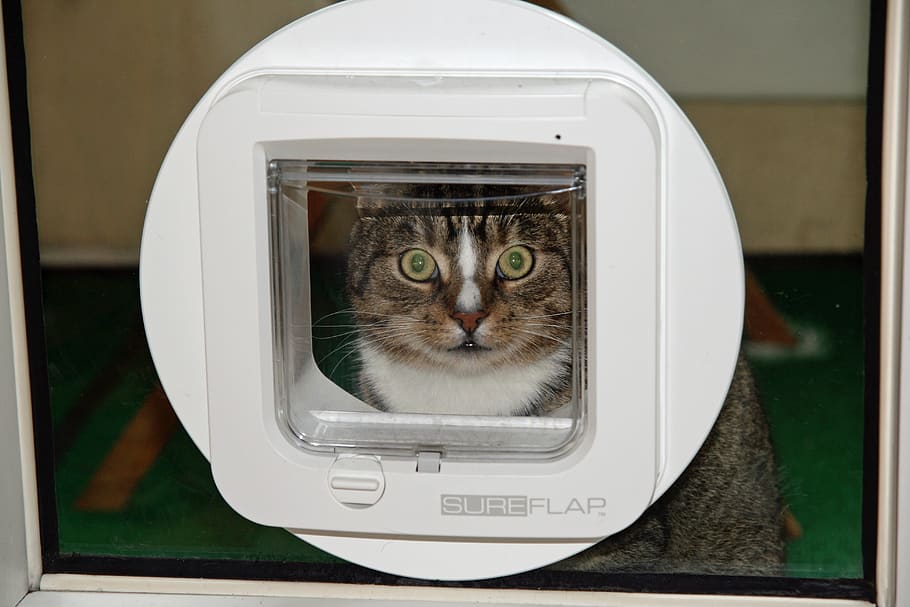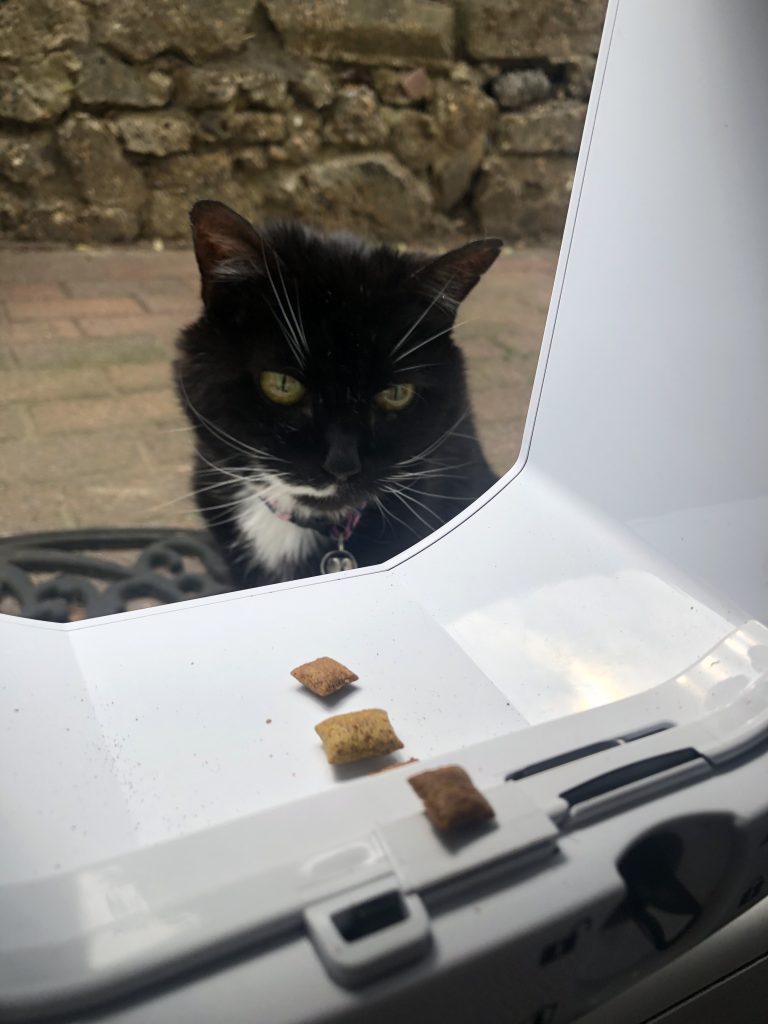Cat flaps allow your cat access to the outdoors and offer them the freedom to come and go as they please However, cats won’t instinctively know how to use them, but how do you teach your cat how to use a cat-flap? This blog will tell you everything you need to know in order to help your kitty have the confidence to come and go as they please!
What type of catflap should I get?
There are lots of options for different types of catflaps. There are the basic ones, which allow your cat to enter and exit as they please. This type can usually be locked to either allow your cat to enter and exit, or locked so they cannot use it at all. Some of them offer 4-way locking, giving you more options as to the access you wish to allow your cat.
There are different sized doors too, which are great if your cat is larger than the average moggie, or if you are hoping to use it for your dog (or kids – I won’t judge you). These are usually the cheapest type, so great if you are on a budget and not looking for anything fancy.
Another type is a magnetic cat flap which works by your cat wearing a magnet (click here if you are in the US) on their collar which unlocks the flap as they approach it. A magnetic cat flap is a good idea if you are worried about other cats coming into your house, however, they do require your cat to wear a collar which may be problematic should your cat regularly lose their collar as it could leave them locked out.
Microchip catflaps are very popular now and much like the magnetic cat flap, work by opening when your cat approaches the door. The difference is you program your cat’s microchip to the flap so only they can use it. Again, this stops unwanted visitors from using it, and if you only want one of your cats using the flap, you could do that too. If your cat’s microchip is unable to be read (some have the wrong amount of numbers and others are low powered), you can get fobs (click here for USA link) for their collar which, when programmed, allow only your pet to use it.
As well as the standard microchip flap as described above, technology is moving quickly and there are now app-controlled cat flaps. You can lock and unlock the flap remotely and set curfew times, as well as allowing you to monitor your cat’s behaviour. The app will tell you when your cat has used the flap and if you have multiple cats, will say which one has entered or exitedwhich cat you have, which is great if you spend a lot of time away from home.
Top tip – make sure you read the manufacturer’s guidelines before installing your catflap as some require adapters for them to be safely installed into glass or walls (USA link for glass or wall adapters).

What’s the best time to train my cat to use a catflap?
If you have a kitten, you shouldn’t let them outside until they are fully vaccinated and neutered. Unvaccinated cats are at risk from a huge range of diseases, some of which can be fatal. Not only can unneutered females come home pregnant, but entire males can roam and fight with other cats. A cat who roams is at more risk from getting lost, or from being involved in a road traffic accident.
If you have an adult cat who has not been outside before, make sure they have been indoors with you for at least 3 – 4 weeks. This gives them time to get used to you, their home, as well and knowing when they will be fed.
If you decide to give your cat a collar, choose a safety collar that will unclip with pressure, meaning your kitty won’t get stuck in a hedge because of their collar. There are lots of reflective collars (USA link) which are a great idea for any cat, but especially dark coloured ones who are harder to see. Most cat collars come with a bell to alert birds, but they also help you hear your cat when they are outside – you can buy extra bells (USA link) if you don’t feel like one is enough.
Before letting any cat outside, make sure they are microchipped and the microchip details are up to date. This will give you the best chance of being reunited should your cat go wondering. You should also make sure they are up to date with any parasite preventative as they could bring little hitchhikers home!
Get your cat used to being fed at set times, and always call them for dinner by shaking their biscuits as this will help you call them back in when they are outside. When you start training your cat, choose a time when your cat is hungry so you can use treats to entice them in at out the flap, and if they are a little hungry, they are less likely to roam too far whilst they are still in training.
How to teach your cat how to use a cat-flap – Don’t let them out through the door
You want your cat to associate the flap with the only way of entering or exiting the house, so if you continue to open the back door for them, they will expect you to do this even when they have learnt the flap. From now on, the cat flap is the only way they can enter or exit the house.
Tempt them with food
Get one person to sit one side of the cat flap, and the other person on the other with the door closed. Hold the flap open for your cat, and call your cat through the cat flap, you may need to entice them with treats (link here for USA readers) so they get the hang of it. Try having one hand on the flap, holding it open and use your other hand to hold the treat and entice them through. If your cat won’t follow your hand, rest some treats on the inside on the flap in a line, and then treat your cat as they jump through.
How do you get your cat to push the flap open?
Once your cat is happy jumping through the cat flap with you holding it open, the next step is to get your cat to understand that they need to push the flap themselves. To do this, open the flap about halfway and call your cat with treats, as they come through, gently drop the flap so it touches your cat as they come through. Repeat this a few times so they get used to the feel of it. Once your cat seems happy with this, open the flap a tiny amount, just wide enough so they can sniff a treat in your hand and they should push through to get the treat. If your cat won’t push the flap on their own, go back a step, hold it open about halfway and repeat for longer.

Never force your cat through the cat flap
It can be frustrating if your cat takes a little while to get the hang of it, but forcing them through can make them afraid of the catflap, which is something we want to avoid! The cat flap should initially be associated with treats, and when they get the hang of how to use a cat-flap, their reward will be either exiting or entering the house.
How do I phase out the litter box?
If you want to phase out the litter box now you have a cat flap, this needs to be slowly. Depending on where the litter box is situated in your house, every day move the litter box closer to the door where the cat flap is. For example, if the litter box is in the bathroom, move it a few feet every day, making sure you haven’t moved it too much too soon or your cat will get confused. Depending on where it is in the house, it may take a week or so but persevere.
Eventually, the litter box will be next to the cat flap. Once your cat has gotten used to using it here, move it outside the back door, right next to the flap. Using the same method, move the litter box up your garden, to a flowerbed you don’t mind your kitty using and they should start using it there. Then, place some of the soil in the catbox so they get used to toileting on soil, rather than litter and when your cat is happy with this, you can remove the litter box. This will only work if you allow your cat free access to the outside. If you want to keep them indoors at night, you must give them a litter tray to use.
Your cat should get used to toileting outside, and will naturally find their own preferred spot to use, meaning your flowers won’t always be wee’d on (hooray!).

Remember, every feline is different and whilst some cats get used to things pretty quickly, others may get stressed or confused with change. If you think your cat is stressed, try going back a step or two, and use lots of praise and positive reinforcement when they do the right thing. It can take some kitties longer than others until they learn how to use a cat-flap, so don’t rush the process.
Want to know more about cats? Check out how kittens develop here!



My cat has been using her cat-flap for about the last 6 months. What worked for me was using food, holding the door open and being patient. Getting her to use her cat-flap was no easy task. At the beginning when I first tried to get her to use her new cat-flap, she would just sit at the other side and mow at me. After a few days however, I placed a string to a screw to hold the door open and I placed her food bowl close to the door when it was her food time. It worked like a charm, she jumped straight through! After that she had no problem using her new cat-flap. The problem came, however when I closed the flap. She would just sit and stare at me and mow until I opened the flap for her. We did this mow and open routine until one night out of the blue she decided, let me just use my cat-flap! Since then she has been using her cat-flap all the time. Once she got over her fear of the flap she was fine and has never gone back! Using food and holding the door open definitely works to encourage your cat to interact with their new door!